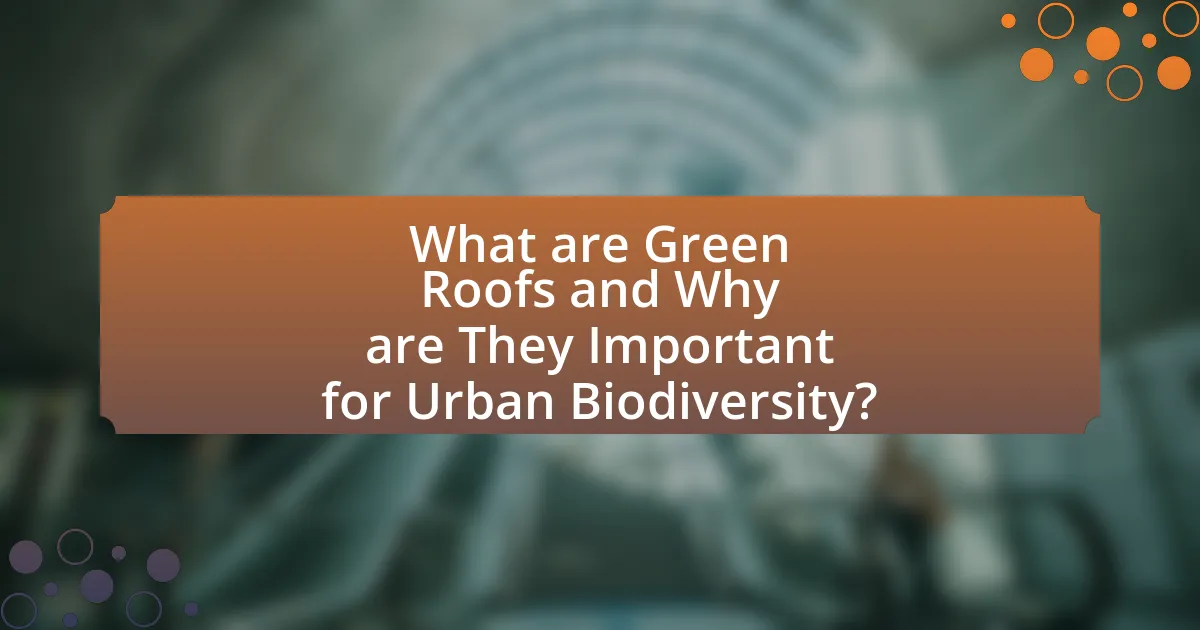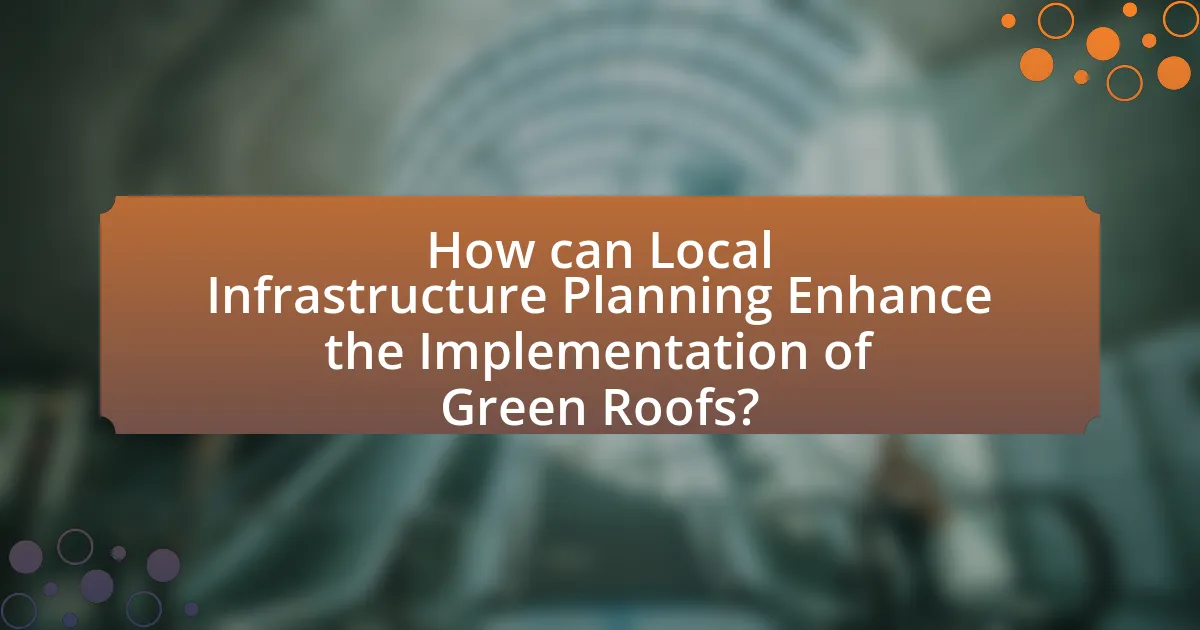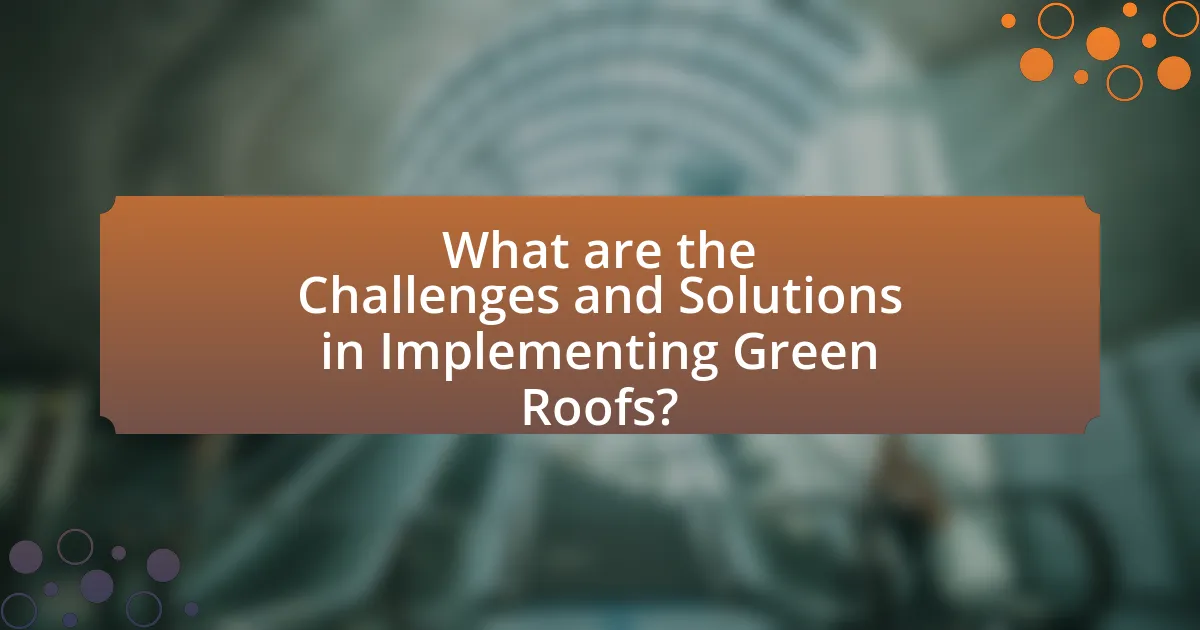Green roofs are vegetated systems installed on building rooftops that provide essential habitats for urban biodiversity, supporting various species such as birds, insects, and plants. This article explores the ecological benefits of green roofs, including their role in enhancing species richness, improving air quality, and mitigating urban heat effects. It also examines the key components of green roofs, the types of vegetation used, and the importance of local infrastructure planning and city policies in promoting their implementation. Additionally, the article addresses challenges in green roof development, such as structural limitations and maintenance needs, while highlighting best practices and community engagement strategies that can enhance their success and sustainability in urban environments.

What are Green Roofs and Why are They Important for Urban Biodiversity?
Green roofs are vegetated systems installed on building rooftops that support plant growth and provide various ecological benefits. They are important for urban biodiversity because they create habitats for various species, including birds, insects, and other wildlife, which are often displaced by urban development. Research indicates that green roofs can enhance species richness and abundance, contributing to urban ecosystems by providing food sources and nesting sites. For example, a study published in the journal “Ecological Engineering” found that green roofs can support a diverse range of plant species and attract pollinators, thereby promoting ecological interactions that are vital for urban biodiversity.
How do Green Roofs contribute to urban ecosystems?
Green roofs contribute to urban ecosystems by providing habitats for various plant and animal species, thereby enhancing biodiversity. These green spaces support pollinators, such as bees and butterflies, which are crucial for plant reproduction and ecosystem health. Research indicates that green roofs can host up to 30 different species of plants and attract numerous insects, contributing to urban ecological networks. Additionally, they improve air quality by filtering pollutants and absorbing carbon dioxide, which mitigates urban heat island effects. Studies show that green roofs can reduce ambient temperatures by up to 5 degrees Celsius, further benefiting urban wildlife and plant life.
What specific biodiversity benefits do Green Roofs provide?
Green roofs provide specific biodiversity benefits by creating habitats for various plant and animal species in urban environments. These green spaces support pollinators, such as bees and butterflies, by offering food sources and nesting sites, which are crucial for their survival in increasingly urbanized areas. Research indicates that green roofs can host a diverse range of flora, with studies showing that they can support up to 30 different plant species, enhancing local biodiversity. Additionally, green roofs contribute to the overall ecological connectivity of urban landscapes, allowing for species movement and interaction, which is vital for maintaining healthy ecosystems.
How do Green Roofs support pollinators and other wildlife?
Green roofs support pollinators and other wildlife by providing essential habitats and food sources in urban environments. These green spaces offer diverse plant species that attract bees, butterflies, and birds, facilitating pollination and promoting biodiversity. Research indicates that green roofs can host a variety of flora, which in turn supports a range of fauna, enhancing ecosystem services in cities. For instance, a study published in the journal “Urban Ecology” found that green roofs can increase local insect populations by up to 30%, demonstrating their role in fostering wildlife.
What are the key components of a Green Roof?
The key components of a Green Roof include a waterproof membrane, a root barrier, drainage layers, a growing medium, and vegetation. The waterproof membrane prevents water from penetrating the building, while the root barrier protects the structure from root damage. Drainage layers facilitate excess water removal, preventing waterlogging. The growing medium, which is typically a lightweight soil mix, supports plant growth and retains moisture. Finally, vegetation, which can include various types of plants, contributes to biodiversity and provides environmental benefits such as improved air quality and insulation.
What types of vegetation are typically used in Green Roofs?
Green roofs typically utilize a variety of vegetation types, including sedums, grasses, herbs, and small shrubs. Sedums are particularly favored due to their drought resistance and low maintenance requirements, making them ideal for the harsh conditions often found on rooftops. Grasses contribute to biodiversity and can help with stormwater management. Herbs not only enhance aesthetic appeal but can also provide functional benefits such as attracting pollinators. Small shrubs may be included in extensive green roofs to add structural diversity and improve habitat for urban wildlife.
How does the design of a Green Roof influence its ecological impact?
The design of a Green Roof significantly influences its ecological impact by determining factors such as plant selection, substrate depth, and water retention capabilities. For instance, diverse plant species can enhance biodiversity by providing habitats for various organisms, while deeper substrates allow for a wider range of plant growth, which can improve carbon sequestration and air quality. Research indicates that Green Roofs with a variety of native plants can support more pollinators and other wildlife, thus contributing to urban biodiversity. Additionally, effective water management in the design can reduce stormwater runoff, mitigating urban flooding and improving water quality.

How can Local Infrastructure Planning Enhance the Implementation of Green Roofs?
Local infrastructure planning can enhance the implementation of green roofs by integrating them into zoning regulations and building codes. This integration ensures that developers are incentivized to include green roofs in new constructions, as seen in cities like Toronto, where policies mandate green roofs on certain buildings. Additionally, local infrastructure planning can allocate funding for green roof projects and provide technical support, which has been effective in cities such as Chicago, where the city’s Green Roof Grant Program has led to the installation of over 5 million square feet of green roofs. By establishing clear guidelines and support mechanisms, local infrastructure planning facilitates the widespread adoption of green roofs, contributing to urban biodiversity and environmental sustainability.
What role do city policies play in promoting Green Roofs?
City policies play a crucial role in promoting green roofs by establishing regulations, incentives, and guidelines that encourage their implementation. For instance, cities may offer tax credits, grants, or subsidies to property owners who install green roofs, making the investment more financially viable. Additionally, zoning laws can be adjusted to require or incentivize green roofs in new developments, thereby integrating them into urban planning. Evidence of this can be seen in cities like Toronto, which has implemented a Green Roof Bylaw mandating green roofs on new buildings over a certain size, resulting in a significant increase in green roof installations and contributing to urban biodiversity.
How can zoning laws be adapted to support Green Roof initiatives?
Zoning laws can be adapted to support Green Roof initiatives by incorporating specific provisions that incentivize or require the installation of green roofs in new and existing developments. For instance, municipalities can offer density bonuses or tax incentives for buildings that include green roofs, thereby encouraging developers to integrate these sustainable features. Additionally, zoning regulations can mandate green roofs in certain districts, particularly in areas with high urban heat island effects or where stormwater management is critical. Evidence from cities like Toronto, which has implemented a Green Roof Bylaw requiring green roofs on new buildings over a certain size, demonstrates that such regulations can effectively promote green infrastructure and enhance urban biodiversity.
What incentives can municipalities offer to encourage Green Roof development?
Municipalities can offer financial incentives such as tax credits, grants, and subsidies to encourage Green Roof development. These financial incentives reduce the initial investment costs for property owners, making Green Roof installations more economically viable. For example, cities like Toronto have implemented a Green Roof By-law that provides financial support through grants, which has led to a significant increase in Green Roof projects, contributing to urban biodiversity and improved stormwater management.
How can community engagement improve Green Roof projects?
Community engagement can significantly improve Green Roof projects by fostering local ownership and ensuring that the designs meet the specific needs and preferences of the community. Engaged communities are more likely to support and maintain these projects, leading to higher success rates. For instance, a study by the University of Toronto found that community involvement in the planning stages of Green Roofs resulted in designs that better reflected local biodiversity and aesthetic preferences, ultimately enhancing ecological benefits and community satisfaction. This collaborative approach not only increases the effectiveness of the Green Roofs but also strengthens community ties and promotes environmental stewardship.
What strategies can be used to involve local residents in Green Roof planning?
To involve local residents in Green Roof planning, strategies such as community workshops, surveys, and participatory design sessions can be employed. Community workshops facilitate direct engagement, allowing residents to express their ideas and preferences regarding green roof features. Surveys can gather broader input on community needs and desires, ensuring that the planning process reflects local priorities. Participatory design sessions actively involve residents in the design process, fostering a sense of ownership and commitment to the project. Research indicates that such inclusive approaches lead to higher satisfaction and better project outcomes, as seen in the case study “Community Engagement in Urban Green Infrastructure” by Smith et al. (2020), which highlights the positive impact of resident involvement on urban biodiversity initiatives.
How does public awareness impact the success of Green Roof initiatives?
Public awareness significantly enhances the success of Green Roof initiatives by fostering community support and participation. When the public is informed about the environmental benefits of green roofs, such as improved air quality, reduced urban heat, and increased biodiversity, they are more likely to advocate for their implementation. Studies indicate that cities with higher public awareness and engagement in sustainability practices see a greater adoption rate of green infrastructure projects. For instance, a survey conducted by the Green Roofs for Healthy Cities organization found that cities with active public outreach programs experienced a 30% increase in green roof installations compared to those without such initiatives. This correlation underscores the importance of educating the public to drive the success of green roof projects.

What are the Challenges and Solutions in Implementing Green Roofs?
The challenges in implementing green roofs include structural limitations, high initial costs, and maintenance requirements. Structural limitations arise because not all buildings can support the additional weight of a green roof, necessitating engineering assessments. High initial costs can deter investment, as the installation of green roofs often requires specialized materials and labor, which can be significantly higher than traditional roofing options. Maintenance requirements also pose a challenge, as green roofs need regular upkeep to ensure plant health and prevent issues such as water pooling or pest infestations.
Solutions to these challenges involve thorough planning, financial incentives, and community engagement. Conducting structural assessments during the design phase can identify suitable buildings for green roofs, while financial incentives, such as grants or tax breaks, can alleviate the burden of high initial costs. Community engagement initiatives can foster public support and awareness, encouraging local governments to prioritize green roofs in urban planning. These strategies have been shown to enhance the feasibility and sustainability of green roof projects, as evidenced by successful implementations in cities like Toronto and Chicago, where supportive policies have led to increased adoption rates.
What common obstacles do developers face when creating Green Roofs?
Developers face several common obstacles when creating green roofs, including structural limitations, high initial costs, and maintenance challenges. Structural limitations arise because not all buildings can support the additional weight of soil and vegetation, necessitating engineering assessments. High initial costs are a significant barrier, as the installation of green roofs often requires specialized materials and labor, which can exceed traditional roofing expenses by 10% to 20%. Maintenance challenges include the need for ongoing care to ensure plant health and prevent issues such as drainage problems, which can lead to costly repairs if not managed properly. These factors collectively hinder the widespread adoption of green roofs in urban environments.
How can cost barriers be addressed in Green Roof projects?
Cost barriers in Green Roof projects can be addressed through financial incentives, such as grants, tax credits, and subsidies. These financial mechanisms encourage property owners and developers to invest in Green Roof installations by reducing upfront costs. For instance, cities like Toronto have implemented a Green Roof by-law that offers financial incentives, resulting in a significant increase in Green Roof installations, which can lead to long-term savings in energy costs and stormwater management. Additionally, public-private partnerships can facilitate funding and resource sharing, making projects more economically viable.
What technical challenges must be overcome for successful Green Roof installation?
Successful Green Roof installation requires overcoming several technical challenges, including structural load capacity, waterproofing, drainage, and plant selection. Structural load capacity must be assessed to ensure the building can support the additional weight of the green roof system, which can exceed 100 pounds per square foot when saturated. Waterproofing is critical to prevent leaks and damage to the underlying structure, necessitating high-quality membranes and proper installation techniques. Effective drainage systems must be designed to manage excess water and prevent root rot, which involves selecting appropriate materials and configurations. Finally, plant selection must consider local climate, maintenance requirements, and biodiversity goals to ensure the green roof thrives and contributes to urban ecology. These challenges are supported by studies indicating that proper planning and execution can significantly enhance the longevity and effectiveness of green roofs in urban settings.
What best practices can ensure the success of Green Roofs?
Best practices that can ensure the success of green roofs include selecting appropriate plant species, ensuring proper drainage, and implementing regular maintenance. Choosing native and drought-resistant plants enhances biodiversity and reduces water usage, while effective drainage systems prevent water accumulation and structural damage. Regular maintenance, including weeding and monitoring plant health, is essential for sustaining the ecosystem and maximizing the benefits of green roofs. Studies show that well-maintained green roofs can reduce urban heat, improve air quality, and support local wildlife, thereby contributing positively to urban biodiversity.
How can maintenance practices enhance the longevity of Green Roofs?
Maintenance practices enhance the longevity of green roofs by ensuring optimal plant health, structural integrity, and efficient water management. Regular inspections and maintenance activities, such as weeding, pruning, and fertilization, promote healthy vegetation, which is crucial for the ecosystem services that green roofs provide. Additionally, maintaining drainage systems prevents water accumulation that can lead to structural damage and plant stress. Research indicates that well-maintained green roofs can last over 40 years, significantly longer than those that are neglected, highlighting the importance of consistent upkeep in maximizing their lifespan and functionality.
What lessons can be learned from successful Green Roof case studies?
Successful Green Roof case studies demonstrate the importance of integrating biodiversity, sustainability, and community engagement into urban planning. These case studies reveal that incorporating native plant species enhances local biodiversity and supports pollinators, as evidenced by the Chicago City Hall Green Roof, which hosts over 20 species of plants and attracts various insects. Additionally, successful projects emphasize the need for proper maintenance and monitoring to ensure long-term viability, as seen in the extensive green roofs of the Bosco Verticale in Milan, which require regular upkeep to thrive. Furthermore, community involvement in the design and implementation phases fosters a sense of ownership and promotes educational opportunities, as highlighted by the Brooklyn Grange rooftop farm, which engages local residents in sustainable practices. These lessons underscore the multifaceted benefits of Green Roofs in urban environments, contributing to ecological health and community well-being.
What practical steps can individuals take to advocate for Green Roofs in their communities?
Individuals can advocate for green roofs in their communities by organizing awareness campaigns that highlight their environmental benefits, such as reducing urban heat and improving air quality. Engaging with local government officials to propose policies or incentives for green roof installations can also be effective; for instance, cities like Toronto have implemented financial incentives that encourage green roof development. Collaborating with local businesses and community organizations to host workshops or informational sessions can further educate residents on the advantages of green roofs, fostering community support. Additionally, individuals can participate in or initiate community projects that demonstrate the feasibility and benefits of green roofs, such as installing a green roof on a community building or school, which can serve as a model for future projects.
